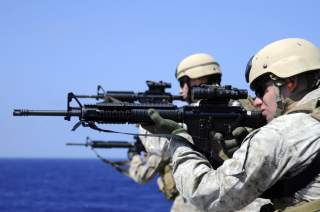Soldiers Hate the M4 and M16. The Pentagon Is Finally Doing Something about It.
So what will they do?
While small arms and other infantry equipment cost far less than the Defense Department’s modernization programs, they have not been a top Pentagon acquisition priority. For decades, expensive weapons programs like the F-35 Joint Strike Fighter and Gerald R. Ford class aircraft carrier have eaten up a large part of the Pentagon’s budget, but Wilkie said the task force will now look at whether the Defense Department needs to spend more money on smaller arms.
For decades, troops have been complaining about the limitations of the M16 rifle and M4 carbine, both of which are hindered by the same flawed operating system that makes the weapons jam easily. But after years of ignoring small arms in favor of expensive aircraft and warships, the Pentagon is taking a long, hard look at how to give the Army 11 Bang Bangs and Marine grunts a better weapon.
Defense Secretary James Mattis has ordered the creation of a task force to make American small arms more lethal to give infantry soldiers and Marines an extra advantage in the close fight, Pentagon personnel chief Robert Wilkie said. It has been decades since the Pentagon last looked at the combat effectiveness of small units.
“We don’t want any more fair fights,” Wilkie told Task & Purpose on Wednesday. “We want to overmatch any adversary out there.”
Close combat, in which opposing troops are no more than 600 meters from each other, accounts for up to 90 percent of U.S. casualties, Wilkie said, and America’s adversaries have made advances in this type of fighting in recent years.
The Israelis had planned to destroy Hezbollah using airpower in 2006, but they found themselves in close combat with a conventionally trained force that lured Israeli tanks and infantry into kill zones.
“The bottom line for us is we don’t want that to happen,” Wilkie said.
To ensure that U.S. troops can annihilate any enemy in the close fight, the new task force will look at how to update troops’ training and equipment based on lessons learned from special operations forces, he said. One aspect of the review is whether infantry soldiers and Marines need a new rifle, he said.
When asked if the Task Force’s work could result in the Army and Marine Corps fielding a new rifle, Wilkie said: “It could. We just haven’t gotten to that point yet.
But Wilkie stressed that the task force’s focus is to make sure that infantry troops have the training to be dominant in the close fight, adding that discussions about how soldiers and Marines are equipped “will flow from that.”
Mattis has said that he wants U.S. troops to experience 25 simulated battles before they get their first actual combat experience, Wilkie said. To accomplish that, the task force will look at expanding the use of simulators that are currently in the works at Fort Benning, Georgia, and Camp Pendleton, California, he said.
Over the last 70 years, small infantry units have done most of the fighting and dying in America’s wars, but a Pentagon Cost Assessment and Program Evaluation review recently determined that infantry troops get less than 1 percent of the Defense Department’s resources for training and equipment, said retired Army Maj. Gen. Robert Scales, who was an advisor to the CAPE review.
Meanwhile, any U.S. casualties can have strategic implications, Scales told Task & Purpose on Feb. 23. For example, the deaths of four soldiers in Niger in October 2017 has led the U.S. military to rethink its entire posture in Africa, he said.
“We’re very, very sensitive to casualties,” Scales said. “So, it make sense to me that the nation should do more to keep alive who are most likely to die.”
While small arms and other infantry equipment cost far less than the Defense Department’s modernization programs, they have not been a top Pentagon acquisition priority.
For decades, expensive weapons programs like the F-35 Joint Strike Fighter and Gerald R. Ford class aircraft carrier have eaten up a large part of the Pentagon’s budget, but Wilkie said the task force will now look at whether the Defense Department needs to spend more money on small arms.
“The focus for this secretary will be on the point of the spear where the most of the casualties occur,” Wilkie said. “We are going to determine whether or not we have devoted sufficient resources to that fight. My view is, yes, we will be spending more money on that.”
Jeff Schogol covers the Pentagon for Task & Purpose. He has covered the military for 12 years and embedded with U.S. troops in Iraq and Haiti. Prior to joining T&P, he covered the Marine Corps and Air Force at Military Times. Follow Jeff Schogol on Twitter @JeffSchogol.
This article originally appeared at Task & Purpose. Follow Task & Purpose on Twitter.
More Articles from Task & Purpose:
- 7 Veteran-Friendly Manufacturers That Are Hiring
- The 6 Types Of Contractors You Encounter Overseas
- Here’s How Marines Fared On The New Physical Fitness Test
Image: Wikimedia Commons

